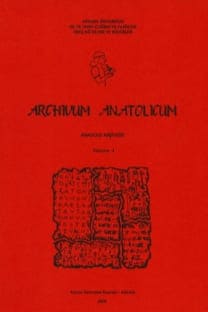AN EXAMPLE OF UNNEEDED LEGITIMIZATION TRADITION IN ANCIENT MEDITERRANEAN REGION: EXPOSE TO WATER
AN EXAMPLE OF UNNEEDED LEGITIMIZATION TRADITION IN ANCIENT MEDITERRANEAN REGION: EXPOSE TO WATER
Abandonment, Prospective Personas, Legitimacy Administration, Deification,
___
- Apol. Apollodorus. The Library. Translate: James George Frazer. London – New York, 1921.
- Arnob. Arnobius. The Seven Books of Arnobius Adversus Gentes. Translate: Archd Hamilton Bryce – Hugh Campbell, Edinburg 1871.
- Catul. Gaius Valerius Catullus. The Poems of Gaius Valerius Catullus. Translate: Charles Stuttaford, London: Chiswick Press, 1912.
- Diod. Diodorus. Diodorus of Sicily. In Twelve Volumes II, English Translation by: C. H. Oldfather, London - Massachusetts: Harward University Press, 1967.
- Julian the Apostate. Julian the Emperor. Containing Gregory Nazianzen’s Two Invectives and Libanius Monody London: George Bell and Sons, 1988.
- Livius. Titus Livius, The History of Rome. Translate: Canon Roberts, London: J. M. Dent & Sons, 1905.
- Mahabbarata. The Mahabbarata of Krishna-Dwaipayana Vyasa. Translated into English Prose from the Original Sanskrit Text by Kisari Mohan Ganguli, XII. 2003.
- Exodus. Old Testament. The King James Version of the Holy Bible, 2004.
- Fasti. Publius Ovidius Naso, Ovid’s Fasti. Translate: James George Frazer, London – Massachusetts: Harward University Press, 1959.
- Meta. Publius Ovidius Naso, Ovid’s Metamorphoses. Translate: A. S. Kline, 2000.
- Paus. Pausanias, Description of Greece. Translete: W. H. S. Jones, London – New York: 1918.
- Plut. Fab. Plutarch, “Fabius”. Plutarch’s Lives. with an English Translation by: Bernadotte Perrin, Great Britain: The Windmill Press, 1932: pp. 11 – 197.
- Plut. Isis. Plutarch, “Isis and Osiris”, Plutarch Moralia. vol: V, with an English Translation by: Frank Cole Babbitt, London: Harward University Press, 2003.
- Plut. Pyrr. Plutarch, “Pyrrhus”, Plutarch’s Lives. Translate: Bernadotte Perrin, London: Harward University Press, 1932: pp. 1 – 47.
- Plut. Romul. Plutarch, “Romulus”, Plutarch’s Lives. Translate: Bernadotte Perrin, London – New York: 1914: pp. 89 – 187.
- Shah. The Shahname of Firdausi. vol. V, Done into English by Arthur George, M. A. and Edmond Warner, London: Trubner’s Oriental Series.
- Strab. Strabon, Geographica. Translate: Adnan Pekman, İstanbul: Arkeoloji ve Sanat Yayınları, 2009.
- Brulé, Pierre. “L'exposition Des Enfants En Grèce Antique : Une Form D'infanticide” Enfances & Psy. 3, 2009: pp. 19 – 28.
- Eliade, Mircea. Mitlerin Özellikleri. Translate: Sema Rifat, İstanbul: Om Yayınevi, 2001.
- Eliade, Mircea. Dinler Tarihine Giriş. Translate: Lale Arslan, İstanbul: Kabalcı Yayınevi, 2003.
- Eliade, Mircea. Demirciler ve Simyacılar. Translate: Mehmet Emin Özcan, İstanbul: Kabalcı Yayınevi, 2003.
- Eliade, Mircea. Rites and Symbols of Initation the Mysteries of Birth and Rebirth. New York: Harper Colophon Books, 1958.
- Erdemir, Hatice Palaz and Erdemir, Halil. “Antikçağ’da Çocuk Olmak: Ölmek ya da Ölmemek”, The Symposium of Violence against Women and Children Proceedings Book. 2012: pp. 643 – 659.
- Frazer, James George. The Golden Bough I. A Study Comparative Religion. New York and London: Macmillan and Co, 1894.
- Frazer, James George. The Golden Bough II. A Study Comparative Religion. New York and London: Macmillan and Co, 1894.
- Frazer, James George. Man, God and Immortality Thoughts on Human Progress. London: Macmillen and Co, 1927.
- Freud, Sigmund. Moses and Monotheism. Translated from the German By Katherine Jones, Hertfordshire: Hogarth Press and the Institute of Psycho – Analysis, 1939.
- Harris, W. V. “Child-Exposure in the Roman Empire”, The Journal of Roman Studies, 84, 1994: pp. 1 – 22.
- Hook, La Rue van. “The Exposure of Infants at Athens”, Transactions and Proceedings of the American Philological Association, 51, 1920: pp. 134-145.
- Lévy-Bruhl, Lucien. İlkel Toplumlarda Mistik Deneyim ve Simgeler. Translate: Oğuz Adanır, İstanbul: Doğu Batı Yayınları, 2006.
- Pedrucci, Giulia. “Breastfeeding Animals and Other Wild “Nurses” in Greek and Roman Mythology”, Gerión, 34, 2016: pp. 307 – 323.
- Otten, Heinrich. Eine Althethitische Erzählung um die Stadt Zalpa. Otto Harrassowitz Wiesbaden: Studien zu den Boğazköy – Texten, 1973.
- Konijnenberg, Marlies. Infanticide and the Social Status of Children As Reflected in Child Burials, Unpublished BA Thesis, 2014.
- Pritchard, J. B. The Ancient Near East. I - An Anthology Of Texts And Pictures. Princeton: Princeton University Press, 1958.
- Philips, F. Carter. “Greek Myths and the Uses of Myths”. The Classical Journal. LXXIV/2, 1979: 155 – 166.
- Rank, Otto. The Myth of the Birth of the Hero A Psychological Interpretation of Mythology. New York: The Journal of Nervous and Mental Disease Publishing Company, 1914.
- Redford, Donald B. “The Literary Motif of the Exposed Child (Cf. Ex. ii 1 – 10)”. Numen, XIV/3, 1967: 209 – 228.
- Westenholz, Joan Goodnick. Legends of the Kings of Akkade: The Texts. Eisenbrauns Publications, 1997.
- ISSN: 1300-6355
- Yayın Aralığı: Yılda 2 Sayı
- Başlangıç: 1995
- Yayıncı: Ankara Üniversitesi
KÜLTEPE’DE 1970 (Kt. v/k) KAZISINDA BULUNMUŞ ARŞİVDEN ÜÇ MEKTUP
DION KHRYSOSTOMOS’TA PRODIKOS’UN “HERAKLES’İN SEÇİMİ”: YENİDEN KURGULAMA, İDEOLOJİ VE ÖYKÜNME
HİTİT SAĞALTMA ve ARINDIRMA RİTÜELLERİNDE ANALOJİLER
PİLAH-İŠTAR’IN EŞLERİ, BOŞANMALARI VE ÇOCUKLARI
Sebahattin BAYRAM, Remzi KUZUOĞLU
AMARNA MEKTUPLARI’NA GÖRE DOĞU AKDENİZ TİCARETİNDE ALAŠİA-MISIR İLİŞKİLERİ
AN EXAMPLE OF UNNEEDED LEGITIMIZATION TRADITION IN ANCIENT MEDITERRANEAN REGION: EXPOSE TO WATER
HİTİTLERİN BATI KARADENİZ BÖLGESİ’NDE YAŞAYAN KOMŞULARI HAKKINDA YENİ BULGULAR
Gülden EKMEN, Hamza EKMEN, Sezer SEÇER
AMICITIA ROMANA: CICERO’NUN LAELIUS DE AMICITIA’SINDA BELİREN ROMALI DOSTLUK ANLAYIŞI
